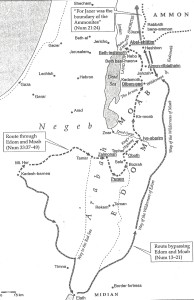When compared to the earlier itineraries of Numbers 20-21 and Deuteronomy 1-3, the itinerary of Numbers 33 bears witness to a number of discrepancies and contradictions after the Israelites leave mount Hor at the end of the 5th month of the final and last 40th year of the wilderness period (Num 33:39). Many of these contradictions have already been discussed:
- While Numbers 33:40 (P) merely notes that the Canaanite king of Arad heard of the Israelites’ coming, the duplicate Hormah tradition now at Num 21:1-3 (see #242) actually claims that the Israelites entered Canaan and defeated the Canaanite king at Hormah, which in and of itself presents an additional number of textual and geographical problems. See A Brief Introduction to Numbers 21, and these contradictions: #268, #269, #270, #271-273, and #274.
- While Numbers 33:41 states that the Israelites move directly from mount Hor to Zalmonah, a city of Edom, Num 21:1-3 claimed they went to Hormah (see #1 above), and Num 21:4 shockingly claimed that they went back down to the Red Sea, which is obviously a misplaced verse. See #268, #274.
- While Numbers 33:41-43 presents the Israelites marching through Edom, the tradition preserved in Num 20:14-21 (J) claims that the Israelites traveled around Edom (#275, #278).
- While Numbers 33:45 states that the Israelites traveled through southern Moab, the tradition preserved in Num 21:21-30 claims that they traveled around southern Moab (see #281, #282-285).
- While Numbers 33:46-49 states that the Israelites merely traveled through northern Moab and then settled on the plains of Moab, the traditions preserved in Num 21:21-35 and Deut 2:24-27, 3:1-13 state that the Israelites settled in northern Moab and proceeded northward into Bashan and conquered that area as well (see #282-285, #286).
A visual of these divergent itineraries can be seen from this map reproduced from Levine’s Anchor Bible commentary on Numbers.

The dotted line at the left represents the itinerary of Numbers 33 (P): the Israelites march through Edom and Moab and settle on the plains of Moab. There is no talk of settlement in northern Moab, nor a Transjordanian conquest of northern Moab and a trek further northward into Bashan and Gilead.
The solid line on the right is the itinerary of Numbers 21 (J): here the Israelites are forced to circumvent Edom, circumvent southern Moab, and enter northern Moab and conquer and settle it, and then continue northward conquering and settling the Bashan and Gilead, and then only afterward turning back to settle on the plains of Moab.
In conclusion, the Priestly tradition of Numbers 33 had no interest in a Transjordanian conquest. Contrary to the earlier traditions of the Yahwist and Deuteronomic, this 6th century BCE writer simply did not preserve it. In his narrative, the Israelites move directly from Hor into and through Edom and Moab, and finally settle on the plains of Moab. This denial of the Transjordanian conquest tradition might have coincided with the historical realities of the Priestly writer’s time period. Historically speaking, the Transjordanian territories flourished from earlier time (how early we’re not sure) till the Assyrian conquest of Israel and Transjordan at the end of the 8th century. Thus there seems to have been little interest in a Transjordanian conquest tradition during the Persian period within which the Priestly source was written.
If the conquest of the transjordan happened well before the Persian period, why would the interest wane? Shouldn’t it at least continue to be a historical source of pride for the Israelites?